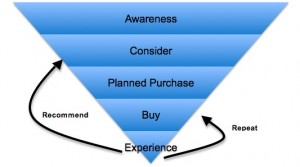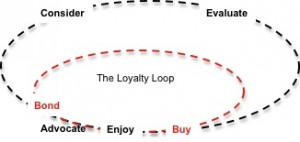Branding in the Digital Age was published in the December 2010 issue of the Harvard Business Review. The author, David C. Edelman, takes the position that because of social media channels consumers connect with brands in new ways. He thinks that the decision purchase funnel (figure 1) no longer applies with social media but rather it is superseded by a new model called the “consumer decision journey” (figure 2). (Edelman, 2010) This is because before the relationship between the consumer and the brand would dissipate post-purchase but now the consumer remains engaged with the brand either promoting or assailing the brand. (Edelman, 2010)
Figure 1- Consumer Purchase Funnel
 Figure 2- Consumer Decision Journey
Figure 2- Consumer Decision Journey
While I do agree with Edelman that with social media the touch points with consumers have changed and in many respects expanded, I do think that he is understating consumer relationships with brands previous to social media. To insinuate that consumers did not promote or assail brands previous to social media is false. In some respects I think of social media as a megaphone. Many of the conversations about brands occurred before the medium existed but now they take place on a much larger scale. While the consumer decision journey (CDJ) clearly demonstrates how building relationships with consumers builds loyalty, the CDJ does not clearly show the how a brand loyal consumer can influence his or her networks. This is one of the keys to social media. With the “megaphone” in front of the consumer, he or she is able to grow the awareness and consideration for the product by advocating on behalf of the brand.
The article does highlight some important implications for marketing in the age of social media.
The first implication is that most advertising and promotion focuses on the consideration and purchase stages while consumers are more influenced during the ‘enjoy’, ‘evaluate’ and ‘bond’ stages. (Edelman, 2010) In the study, when it came time to evaluate a product, consumers tended to go to Amazon.com or retailer websites to compare products through visuals, descriptions and reviews. (Edelman, 2010) Most of this occured off of the manufacturer’s website. (Edelman, 2010) This is important because social media offers more touch points with a brand and therefore the brand can communicate with the consumer at various stages while the consumer is deciding on the purchase and experiencing the brand. (Edelman, 2010) Online touch points allow the consumer to share a trial of a product or service or his or her brand experience. It also highlights the importance of external brand communication relative to what the brand itself is communicating. When evaluating products or services peers and experts are trusted and relied upon much more than the organization itself.
This leads to the second implication that marketers should focus on driving advocacy rather than media spend. (Edelman, 2010) Again with using the megaphone analogy, investing in driving advocacy will allow more consumers to louder and more frequently about the brand. This increases its share of the conversation. It is important to recognize that whether this is good or bad is dependant on what consumers are saying about the brand itself. If a brand is not able to deliver on its promise, providing infrastructure for consumers to share brand experiences may result in a lot of negative conversations about the brand.
The third implication is that marketing now requires greater coordination across all touch points. (Edelman, 2010) As the article highlights, touch points can fall across different business functions website, packaging, customer service. (Edelman, 2010) Also through social media touch points can exist outside of the organization entirely (ie. Facebook and Twitter). Therefore, to ensure that the brand is being represented consistently across all channels and delivers on its brand promise, Edelman recommends that the organization have an “orchestrator” such as a chief marketing officer to ensure the consistency of the brand across all touch points. (Edelman, 2010) I think that this is a valuable suggestion. One of the challenges in implementation will be maintaining consistency in those organizations that are houses of brands but share some functions such as customer service (ie. Proctor & Gamble).
The fourth implication is that communication is no longer one way. (Edelman, 2010) Traditional media is all about broadcasting a message. However, with social media communication is two-way. Organizations now need to pay attention to earned media and what is being communicated about the brand. The significance of this for Edelman is that marketing budgets are allocated based on a strategy that only broadcasts information and does not take into account the resources needed for social media. (Edelman, 2010)
Overall, I think that there are some issues with reframing the funnel as a consumer decision journey. Mainly that the model does not clearly illustrate how a consumer can pull others into the ‘journey’ or ‘funnel’. Another issue is that the article falsely presumes that bonding with a brand does not occur without social media. I think that a simpler way of looking at social media is that it is a megaphone for the word of mouth conversations about a brand that historically took place offline. Whether it is beneficial or detrimental to a brand depends entirely on the whether the product or service is able to live up to its brand promise.
Edelman, D. C. (2010). Branding in the Digital Age: Your’re Spending Your Money in all the Wrong Places. Harvard Business Review , 62-69.

